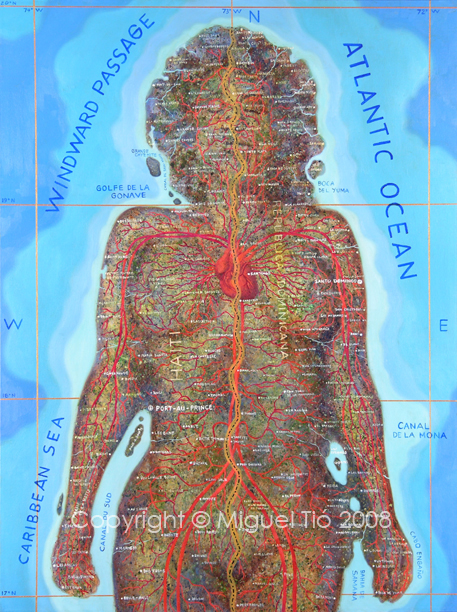|
"Motherland" Oil, egg tempera on canvas Mische Technique 30" x 40", 2007
Click to see a detail June 2007 Last year, I was invited to a friend’s apartment for a gathering of a small group of people who had in common only the fact that we were all from the Dominican Republic. At one point, someone raised the topic of the current situation between Haitians and Dominicans, which quickly led all the guests engage into a very intense discussion… The problem between Haitians and Dominicans arose over the course of many generations, owing to our being two nations sharing a single island, each nation of a different language and culture. Scores of hundreds of people have died over these differences through the history of both countries. The Dominican dictator Trujillo murdered thousands of blacks, regardless of Haitian and Dominican nationality. This was part of his horrific campaign of “ blanqueamiento “ : a scheme that his administration brought to fruition with the intended goal of whitening or bleaching a nation that he personally felt was simply "too dark in complexion". The river at the border between the Dominican Republic and Haiti ran red with their blood, coming to be known as the Rio Masacre in recognition of the indiscriminate butchering. Here is a link to know more about this: http://www.ahadonline.org/eLibrary/creoleconnection/number17/cambeira.htm Nowadays, the main source of conflict is the many Haitians who cross the Dominican border in search of a better life, much in the same way that Dominicans cross the “Canal de la Mona” to Puerto Rico. Dominicans embark on this very unsafe voyage knowing that many will never make it to the other shore; but for Haitians, the lack of a natural barrier is supplanted by the intense discrimination and violence they face once in the Dominican Republic. Many Dominicans of Haitian descent have never even visited Haiti, coming from families that have lived in the country for generations. They are denied their constitutional right to citizenship and the necessary documents for a legal identity, being often repatriated to a “home country” with whom they have no actual ties and whose language they don’t speak. If this sounds familiar to residents of the United States, perhaps it is with good reason. During the discussion in my friend’s apartment I fell silent out of recognition that I have been in New York for 12 years and have, to a certain extent, avoided the current situation in the Dominican Republic. But, during the discussion, I started to visualize the painting you see now. For weeks, the discussion resounded within in me, nurturing my mental image of this conceptual piece, which I call “Motherland” It is dedicated to all my Haitians and Dominican friends Miguel Tió
Copyright © by Miguel Tió |
